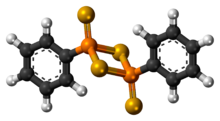Woollins' reagent
 |
|
 |
|
| Names | |
|---|---|
|
IUPAC names
2,4-Diphenyl-1,3,2,4-
diselenadiphosphetan-2,4-diselenide |
|
| Other names
Woollins' Reagent
|
|
| Identifiers | |
| 122039-27-4 | |
| 3D model (Jmol) | Interactive image |
| ChemSpider | 4242993 |
| ECHA InfoCard | 100.155.582 |
| PubChem | 5066075 |
|
|
|
|
| Properties | |
| C12H10P2Se4 | |
| Molar mass | 532.04 g·mol−1 |
| Appearance | red powder |
| Melting point | 192 to 204 °C (378 to 399 °F; 465 to 477 K) |
| soluble in toluene at elevated temperatures | |
| Hazards | |
| R-phrases | R23/25 R33 R50/53 |
| S-phrases | (S1/2) S20/21 S28 S45 S60 S61 |
| Related compounds | |
|
Except where otherwise noted, data are given for materials in their standard state (at 25 °C [77 °F], 100 kPa).
|
|
|
|
|
| Infobox references | |
Woollins' reagent is an organic compound containing phosphorus and selenium. Analogous to Lawesson's reagent, it is used mainly as a selenation reagent. It is named after Professor John Derek Woollins, who is currently the Vice Principal of Research at the University of St Andrews.
Woollins' reagent is commercially available. It can also be conveniently prepared in the laboratory by heating a mixture of dichlorophenylphosphine and sodium selenide (Na2Se), (itself prepared from reacting elementary selenium with sodium in liquid ammonia). An alternative synthesis is the reaction of the pentamer (PPh)5 with elemental selenium.
The main use of Woollins' reagent is the selenation of carbonyl compounds. For instance, Woollins' reagent will convert a carbonyl into a selenocarbonyl. Additionally, Woollins' reagent has been used to selenonate carboxylic acids, alkenes, alkynes, and nitriles.
...
Wikipedia
